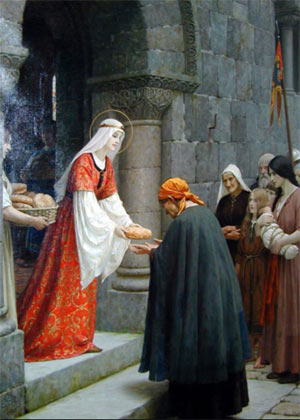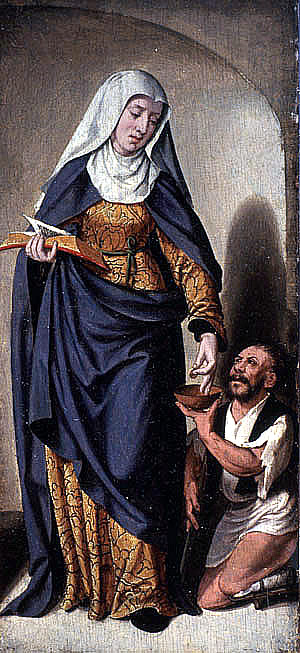
Elizabeth of Hungary---Helper of the Poor
(1207-1231)
Daughter of a king, wife and mother of princes, Elizabeth used her royal revenue for the distressed. During a famine she fed nine hundred at her palace gate. She helped build a hospital and cared for the sick.
Although she died when she was only twenty four, the story of her consecration to God and her noble acts of charity has continued to inspire many to a higher way of life for more than nine centuries.
She was the daughter of a king, and the wife of a prince, but she wore her regal honors humbly. She gave up her fine clothes for a plain grey Franciscan robe and wore it with such grace that others were uplifted by her queenliness. She lived in a troubled time of cultural confusion, but she brought freshness and poise wherever she appeared.
Elizabeth was born in 1207 in the royal castle of Pozsony. She was reared in Wartburg Castle, a gray structure that rose from the mist and snowy pines of a Thuringian forest near the medieval town of Marburg in Hesse. At Wartburg she spent a very happy childhood, but when Elizabeth was seven her mother died, and she learned as a young girl to take her perplexities into the Wartburg chapel.
She came from a deeply religious family. Her mother, Gertrude, belonged to a long line of Christians. Her mother's sister, Hedwig, founded a convent for lepers after rearing her six children. Her father, Andrew II, was noted for his generosity toward the church and the poor.
At only 14, Elizabeth married King Louis IV. She and her husband agreed to rule their people justly and to welcome religious orders into their castle.
Elizabeth had four children, and after the birth of each child she walked barefoot over the rough roads to St. Katherine's Chapel. She thanked God for the delivery of her child and recited the Psalm: "Children are a heritage of the Lord; and the fruit of the womb is His reward. As arrows are in the hands of a mighty man, so are children of the youth." (Psalm 127: 3-4)
Elizabeth's life of good works and devotion had roots in her early training. In her childhood she had heard from her father the story of St. Francis of Assisi. The secret of his life became the secret of hers. Like him, she was sustained by a double joy, the joy of love and the joy of suffering for love. She said of Jesus "do thou, by thy most bitter death, give me a lively faith, firm hope and perfect charity."
Among the miseries of Elizabeth's age was leprosy. The lepers in their coarse gray gowns were dreaded and loathed, and many were forced to wander till they died. Elizabeth, remembering that Christ ate in the house of a leper and that He bade His disciples to heal the sick and cleanse the lepers, devoted herself to the most menial service for these poor creatures. She eventually built a home for lepers.
At the end of her life, she renounced all material things---in her heart she had long before abandoned them---she found greater spiritual fulfillment. Again she served the lepers, the aged, the poor. She took the vows of the Third Order of St. Francis, wishing to eschew the pomp of the world for the love of Christ.
It is said of Catherine, "she no longer felt herself a princess but His humble servant." Elizabeth learned to accept all of her trials by thinking only of Christ's suffering and of how people had mocked Him too.
She was a royal princess who sought to be glorious within.
(All information from "Great Women of the Christian Faith" By: Edith Deen)

No comments:
Post a Comment